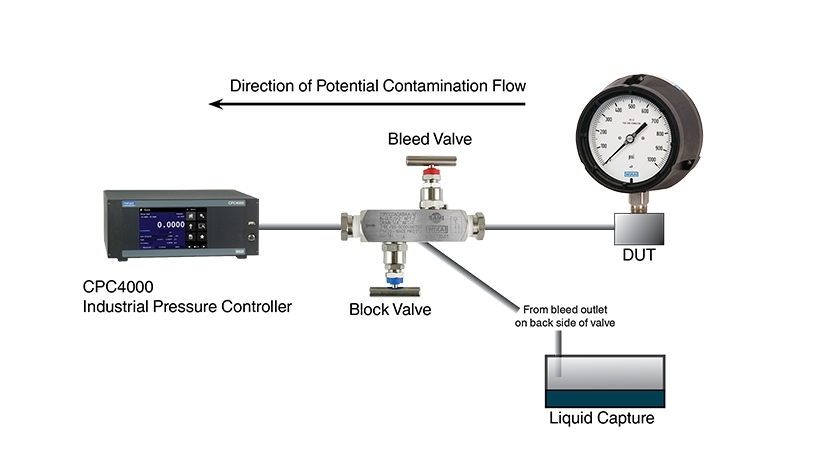
A block and bleed valve can be used to prevent flow of contamination from a device under test (DUT) to a pressure controlling calibrator. This procedure includes “exercising” and purging the DUT and the actual calibration. Your procedure may be different but the essential principal of preventing flow from the DUT to the controller can be applied to any procedure.
Exercise and purge the DUT
- Before connecting the DUT to the system, remove as much liquid as possible from the DUT.
- With the controller power off and both the block and bleed valve closed, connect the system as shown above.
- Use the controller to apply a pressure close to the full scale pressure of the DUT.
- Open the block valve slowly to pressurize the DUT. (note: the gas will flow from the controller to the DUT – high to low pressure).
- After the system is pressurized close the block valve.
- Open the bleed valve and purge the system to atmospheric pressure. Observe the sump to see if any liquid is purged.
- Close the bleed valve.
- Repeat steps 3 to 7 as required to “exercise” the DUT or until no liquid is observed coming out of the system.
- With the block and the bleed valves closed, vent the controller.
Calibration procedure
Note: When controlling downscale or venting the controller from a pressure above atmospheric pressure, the pressure media connected to the Measure/Control port will flow through the controller’s regulator and out through the exhaust or vent port. Adding a block and bleed valve and following the procedure below will prevent containments in the DUT from entering the controller.
Going downscale
- Continuing from the full scale value in the upscale calibration, Step 5
- Close the block valve.
- Open the bleed valve slightly, then close it after the pressure on the DUT decreases to a value less than or equal to the next set point going down scale.
- Enter a set point in the controller equal to the next set point going down scale. Note: The controller, in control mode, will immediately control to the set point entered. During this operation the controller is venting gas through the controller’s regulator out through the exhaust port, but because the block valve is closed potential contamination from the DUT is isolated.
- When the controller becomes stable, open the block valve.
- Take the reading from the controller and the DUT and record.
- Repeat steps 2 – 6 until a reading has been taken for the last set point above zero.
- With the block valve closed, put the controller in vent mMode.
- Open the bleed valve and take a zero reading from the DUT.

